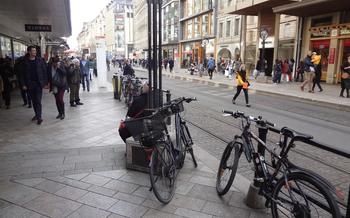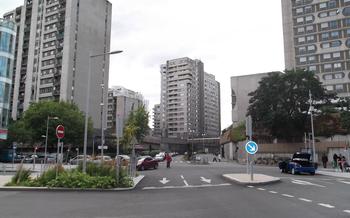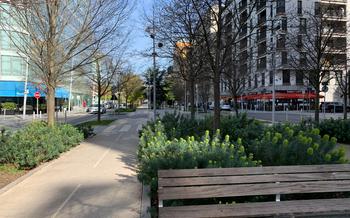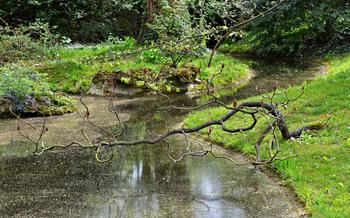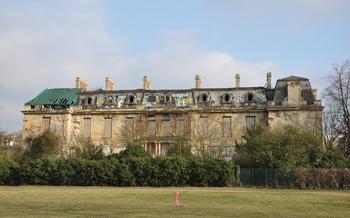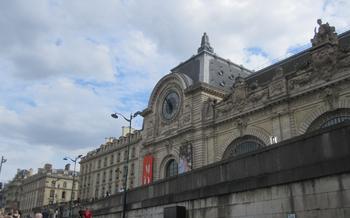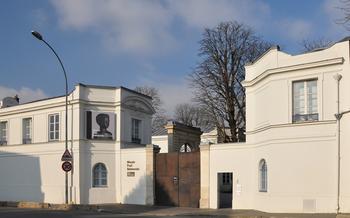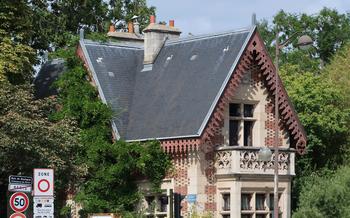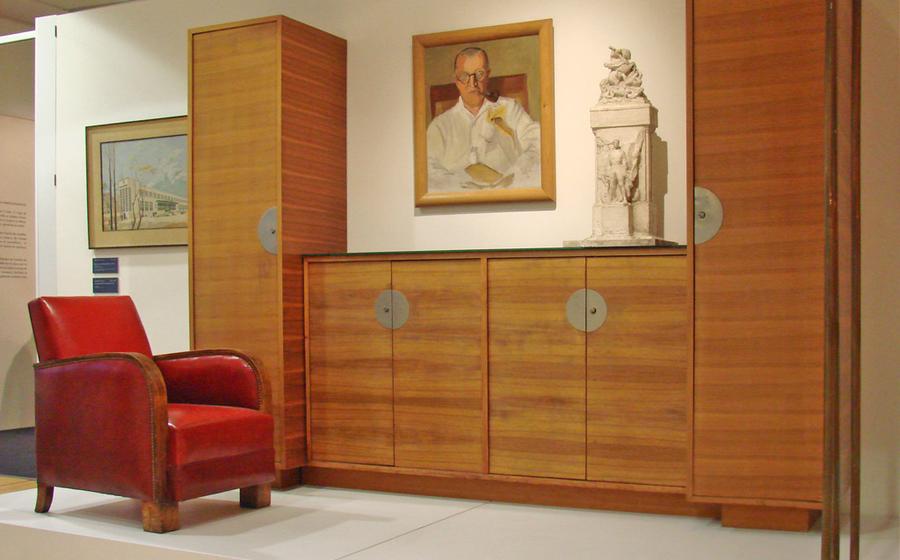
Musée des années 30
- History of the Musée des années 30
- Highlights of the Collection
- Guided Tours
- Educational Programs
- Museum Shop
- Accessibility
- Hours of Operation
- Admission Prices
- Location and Transportation
- Food and Drink
- Nearby Attractions
- Special Events
- Photography and Videography
- Insider Tip
History of the Musée des années 30
The Musée des années 30, or Museum of the 1930s, is a unique institution dedicated to preserving and showcasing the art and culture of the 1930s in France. Founded in 1994 by the Boulogne-Billancourt City Council, the museum is housed in a magnificent Art Deco building that was originally built as a school in 193The collection, which includes over 10,000 objects, was assembled over many years from a variety of sources, including private donations, purchases, and loans. The museum's mission is to promote the study and appreciation of the 1930s, a period of great cultural and social change in France. Through its exhibitions, educational programs, and publications, the museum provides visitors with a glimpse into the vibrant world of the 1930s.
The 1930s was a time of great economic and social upheaval in France. The Great Depression, which began in 1929, had a devastating impact on the country, leading to widespread unemployment and poverty. However, the period also saw a flowering of artistic and cultural activity. The 1930s was a time of experimentation and innovation in art, literature, and music. The museum's collection reflects the diversity and richness of the 1930s, with works by some of the most important artists and designers of the period.
Highlights of the Collection
The Musée des années 30 houses a remarkable collection of Art Deco artifacts that showcase the artistic and cultural currents of the 1930s. Upon entering the museum, visitors are greeted by a stunning array of Art Deco furniture, designed with clean lines and bold geometric shapes. These pieces embody the essence of the Art Deco style, characterized by its emphasis on functionality and elegance.
Among the highlights of the furniture collection are several exquisite pieces by renowned designers such as Jacques-Émile Ruhlmann, Jean Dunand, and Emile-Jacques Ruhlmann. These pieces demonstrate the mastery of craftsmanship and attention to detail that characterized the Art Deco movement. Visitors can admire the intricate marquetry, lacquered surfaces, and polished chrome accents that adorn these exceptional works of art.
The museum also features a significant collection of paintings and sculptures from the 1930s. These works explore a variety of themes, including the human form, urban landscapes, and industrialization. Visitors can appreciate the diverse artistic styles of the period, from the vibrant colors and bold brushstrokes of the Fauves to the more subdued tones and geometric forms of the Cubists.
For those interested in fashion and jewelry, the Musée des années 30 offers a glimpse into the sartorial trends of the 1930s. The collection includes a range of clothing and accessories, from elegant evening gowns to sporty sportswear, all of which reflect the changing social and cultural norms of the era. Visitors can admire the intricate beadwork, delicate lace, and striking color combinations that characterized Art Deco fashion.
Finally, the museum's collection of decorative arts provides a comprehensive overview of the diverse range of objects that were produced during the 1930s. From ceramics and glassware to metalwork and textiles, these pieces showcase the innovative designs and materials that were popular during this period. Visitors can appreciate the exquisite craftsmanship and attention to detail that went into the creation of these everyday objects, which transformed ordinary items into works of art.
Guided Tours
Guided tours of the Musée des années 30 are available in French and English. Tours are led by knowledgeable docents who provide insights into the museum's collection and history. Tours typically last for about an hour and are limited to 15 people.
To book a tour, please contact the museum's education department at least two weeks in advance. The cost of a tour is €5 per person, in addition to the museum's admission fee.
Tours can be customized to fit the interests of the group. For example, groups can request a tour that focuses on a particular aspect of the collection, such as Art Deco furniture or fashion. Groups can also request a tour that is tailored to their educational needs.
Guided tours are a great way to learn more about the Musée des années 30 and its collection. They are also a great way to get a behind-the-scenes look at the museum's operations.
Educational Programs
The Musée des années 30 offers a variety of educational programs for visitors of all ages.
Workshops for Children The museum offers a variety of workshops for children, led by experienced educators. These workshops are designed to teach children about the history of the 1930s through art and interactive activities.
Lectures and Symposia The museum regularly hosts lectures and symposia on a variety of topics related to the 1930s. These events are open to the public and are a great way to learn more about the era from experts in the field.
Outreach Programs The museum also offers outreach programs to schools and community groups. These programs bring the museum's collection and educational resources to students and adults who may not be able to visit the museum in person.
Online Resources The museum's website offers a variety of online resources, including virtual tours, educational activities, and research tools. These resources are a great way to learn more about the 1930s from the comfort of your own home.
The Musée des années 30's educational programs are a great way to learn more about the history of the 1930s and to engage with the museum's collection.
Museum Shop
The Musée des années 30's gift shop is a treasure trove of unique and stylish items inspired by the Art Deco period. From replicas of iconic furniture and decorative objects to books, posters, and jewelry, there's something for everyone, regardless of budget.
Prices range from a few euros for postcards and souvenirs to hundreds of euros for limited-edition prints and sculptures. The shop also offers a selection of vintage items, such as clothing, jewelry, and furniture, which are sure to appeal to collectors and enthusiasts.
The museum shop is located on the ground floor of the museum, near the entrance. It is open during the same hours as the museum itself. Visitors can pay for their purchases in cash, by credit card, or by contactless payment.
Whether you're looking for a special gift for someone special or simply a souvenir to remember your visit, be sure to check out the Musée des années 30's gift shop. You're sure to find something that you'll love.
Accessibility
The Musée des années 30 is committed to providing equal access to all visitors. The museum is wheelchair accessible, with ramps and elevators throughout the building. Strollers are also permitted in the museum.
For visitors with disabilities who require additional assistance, the museum offers a number of services. These include:
- Wheelchair rentals: Wheelchairs are available for rent at the museum's information desk.
- Assistive listening devices: Assistive listening devices are available for use in the museum's auditorium.
- Large print materials: Large print materials, including maps and brochures, are available upon request.
- Service animals: Service animals are welcome in the museum.
The museum also offers a number of programs and services for visitors with cognitive disabilities. These include:
- Sensory-friendly tours: Sensory-friendly tours are offered on a regular basis. These tours are designed for visitors with autism spectrum disorder, sensory processing disorder, or other cognitive disabilities.
- Social stories: Social stories are available to help visitors with cognitive disabilities understand what to expect during their visit to the museum.
- Quiet spaces: Quiet spaces are available throughout the museum for visitors who need a break from the hustle and bustle.
The Musée des années 30 is committed to making the museum accessible to all visitors. If you have any questions or concerns about accessibility, please do not hesitate to contact the museum's information desk.
Hours of Operation
The Musée des années 30 is open to the public from Tuesday to Sunday, from 10 am to 6 pm. It is closed on Mondays and on public holidays. On the first Sunday of each month, the museum offers free admission to all visitors.
During the summer months (July and August), the museum extends its hours and is open from 10 am to 7 pm. This allows visitors to take advantage of the longer days and enjoy the museum's collection and exhibitions in a more relaxed atmosphere.
It is important to note that the museum may have special hours or closures during certain events or holidays. It is always a good idea to check the museum's website or call ahead to confirm the hours of operation before planning your visit.
Admission Prices
Admission to the Musée des années 30 is €9 for adults, €7 for seniors and students, and free for children under 1There are also family tickets available for €20, which admit two adults and two children.
The museum offers a number of discounts and free admission times. For example, admission is free for all visitors on the first Sunday of each month. There are also discounts for groups of 10 or more people.
Tickets can be purchased online or at the museum's ticket counter. Online tickets are slightly cheaper than tickets purchased at the door.
The Musée des années 30 is a great value for the price of admission. The museum has a large and varied collection of Art Deco artifacts, and the temporary exhibitions are always interesting and informative. The museum is also a great place to learn about the history of the 1930s in France.
Location and Transportation
The Musée des années 30 is located at 28 Avenue André Morizet, 92100 Boulogne-Billancourt, France. It is easily accessible by public transportation. The closest Metro station is Boulogne-Jean Jaurès, which is served by Line From the station, it is a short walk to the museum. There are also several bus lines that stop near the museum, including lines 126, 175, and 220.
If you are driving to the museum, there is a paid parking lot located next to the museum. The entrance to the parking lot is on Rue de l'Ancienne Mairie. There is also street parking available in the surrounding area.
The museum's address is:
Musée des années 30 28 Avenue André Morizet 92100 Boulogne-Billancourt France
To get to the museum by public transportation, take the following steps: - Take the Metro to Boulogne-Jean Jaurès (Line 10). - Exit the station and walk towards the Seine River. - Turn right onto Avenue André Morizet. - The museum is located on the left-hand side of the street, after the intersection with Rue de l'Ancienne Mairie.
To get to the museum by car, take the following steps: - Take the Boulevard périphérique (A86) to the Porte de Saint-Cloud exit. - Follow the signs for Boulogne-Billancourt. - Turn right onto Avenue André Morizet. - The museum is located on the left-hand side of the street, after the intersection with Rue de l'Ancienne Mairie.
Food and Drink
If you're looking for a bite to eat, there are several restaurants and cafes near the Musée des années 30. For a quick and casual meal, you can grab a sandwich or salad at one of the many boulangeries or cafes in the neighborhood. If you're looking for something more substantial, there are several restaurants within walking distance of the museum that offer a variety of cuisines, from French to Italian to Japanese.
If you're on a budget, you can also pack a lunch and enjoy a picnic on the museum grounds. There are several benches and tables scattered throughout the property, so you can easily find a spot to relax and eat your meal.
If you're in need of a quick snack or drink, there are also vending machines located in the museum. The machines offer a variety of snacks and beverages, including chips, candy, and sodas.
Nearby Attractions
The Musée des années 30 is surrounded by a wealth of other cultural attractions. Just a short walk away is the Musée National de la Céramique, which houses a world-renowned collection of ceramics from around the globe. Also nearby is the Musée de la Mode et du Textile, which tells the story of fashion and textiles from ancient times to the present day.
For those interested in history, the Musée de l'Armée is a must-see. This museum is home to a vast collection of military artifacts, including weapons, uniforms, and vehicles. And for those who love the outdoors, the Parc de Saint-Cloud is a beautiful spot to relax and enjoy a picnic.
With so much to see and do, the Musée des années 30 is the perfect place to start your exploration of Boulogne-Billancourt. Whether you're interested in art, history, or fashion, you're sure to find something to your taste.
Special Events
The Musée des années 30 hosts a variety of special events throughout the year, making it a vibrant and dynamic cultural hub. These events provide an opportunity for visitors to engage with the museum's collection and mission in new and exciting ways.
Concerts and Performances:
The museum's intimate auditorium hosts a diverse range of concerts and performances, showcasing talented musicians, dancers, and actors. From classical recitals to contemporary performances, these events offer a unique opportunity to experience the museum's collection in a new light.
Film Screenings:
The museum's cinema screens a variety of films from the 1930s and 1940s, providing a glimpse into the era that the museum celebrates. From classic Hollywood blockbusters to obscure European art films, these screenings offer a cinematic journey through the past.
Lectures and Readings:
The museum regularly hosts lectures and readings by experts in the fields of art, history, and culture. These events provide an opportunity for visitors to learn more about the museum's collection, the era of the 1930s, and the broader cultural context in which it existed.
Family Days:
The museum offers a variety of family-friendly events throughout the year, designed to engage and educate children of all ages. These events may include workshops, storytelling sessions, and hands-on activities that bring the museum's collection to life for young visitors.
These special events offer a unique and memorable way to experience the Musée des années 30. Whether you are a history buff, an art enthusiast, or simply looking for a fun and educational day out, the museum's special events are sure to have something to offer.
Photography and Videography
At the Musée des années 30, photography and videography are generally allowed for personal, non-commercial use. Visitors are encouraged to capture their experiences and share their photos and videos online, using the hashtag #MuseeDesAnnees30. However, there are a few restrictions to keep in mind.
-
Flash photography is not permitted in the museum. This is to protect the delicate artworks and objects on display.
-
Tripods, monopods, and other camera supports are not allowed in the museum. These items can obstruct the flow of visitors and damage the museum's floors.
-
Photography and videography are not permitted in the museum's temporary exhibition galleries. This is to protect the privacy of the artists and the integrity of the exhibitions.
Visitors who violate the museum's photography and videography policies may be asked to leave the museum.
Photo Opportunities
The Musée des années 30 is a treasure trove of photo opportunities. Some of the most popular spots for photos include:
-
The Art Deco furniture collection. The museum's collection of Art Deco furniture is world-renowned. Visitors can capture stunning photos of the sleek lines and elegant curves of these iconic pieces.
-
The paintings and sculptures. The museum's collection of paintings and sculptures includes works by some of the most famous artists of the 1930s. Visitors can take photos of these masterpieces and learn more about the artists who created them.
-
The fashion and jewelry collection. The museum's collection of fashion and jewelry is a must-see for anyone interested in 1930s style. Visitors can take photos of the exquisite gowns, hats, and jewelry that were worn by the fashionable elite of the era.
-
The decorative arts collection. The museum's collection of decorative arts includes a wide range of objects, from ceramics and glass to textiles and metalwork. Visitors can take photos of these beautiful and unique objects and learn more about the history of decorative arts.
Sharing Your Photos and Videos
Visitors are encouraged to share their photos and videos of the Musée des années 30 online, using the hashtag #MuseeDesAnnees30. The museum loves to see how visitors experience and interpret the collection.
By sharing your photos and videos, you can help to promote the museum and its mission to preserve and celebrate the culture of the 1930s.
Insider Tip
For a truly immersive experience, plan your visit to coincide with one of the museum's many special events. From concerts and film screenings to lectures and family days, there's always something happening at the Musée des années 30. These events offer a unique opportunity to learn more about the museum's collection and the history of the 1930s.
If you're on a budget, take advantage of the museum's free admission on the first Sunday of every month. This is a great way to save money and still enjoy all that the museum has to offer.
To avoid the crowds, visit the museum during the week or on a weekend morning. The museum is typically busiest in the afternoons, especially on weekends.
Finally, don't forget to visit the museum shop before you leave. The shop sells a variety of souvenirs, including books, posters, and postcards. It's a great place to pick up a unique gift or memento of your visit.
